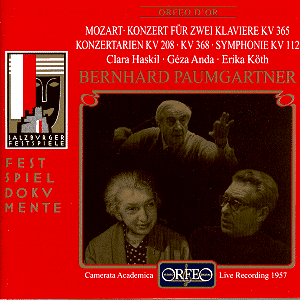 Composer: Wolfgang Amadeus Mozart
Composer: Wolfgang Amadeus Mozart
Works: Overture: Der Schauspieldirektor; Concerto for Two Pianos in E flat major, K365; Aria: L’amero, saro costante, K208 (Il re pastore); Concert Aria: Ma, che vi fege, o stelle, K368; Symphony in F major, K112
Performers: Clara Haskil, Géza Anda (pianos); Erika Köth (soprano); Camerata Academica Salzburg
Recording: Recorded 4 August 1957, Mozarteum Salzburg
Label: ORFEO C 572 011 B
Mozart’s oeuvre brims with a remarkable variety of forms and styles, and this recording offers a fascinating glimpse into his compositional genius across several genres. The selections presented here, ranging from operatic arias to orchestral music, showcase not only the versatility of the composer but also the interpretative prowess of the performers. The Overture to “Der Schauspieldirektor” sets an animated tone, with its rapid thematic exchanges and lively orchestration. Yet, as the performance unfolds, one cannot help but notice the limitations of the recording’s sound quality, which, despite its historical charm, often detracts from the overall clarity and impact of the music.
The Concerto for Two Pianos in E flat major, K365, performed by Haskil and Anda, reveals the strengths and weaknesses of this recording. Here, the interplay between the two pianists is both intimate and dynamic, their partnership a testament to their shared interpretative vision. Haskil’s nuanced touch complements Anda’s more vigorous style, creating a balanced dialogue that is both engaging and compelling. Nevertheless, the dimness of the sound persists, which diminishes the brilliance of their playing, particularly in the more intricate passages. The engineering, while reflective of its time, fails to capture the full spectrum of the pianistic textures, leaving moments that should shimmer instead feeling muted.
Erika Köth’s contributions elevate the recording significantly, particularly in the arias from “Il re pastore” and “Ma, che vi fege, o stelle.” In “L’amero, saro costante,” Köth’s voice resonates with a warmth and clarity that is strikingly well captured, drawing the listener into the emotional core of the piece. Her phrasing under Paumgartner’s sensitive direction is particularly noteworthy; he expertly shapes the contours of the aria, allowing Köth’s artistry to shine. The coloratura demands of “Ma, che vi fege, o stelle” are met with precision and poise, showcasing Köth’s technical skill and interpretative depth. This aria, originally composed for the coloratura role of Elettra in “Idomeneo,” provides an excellent platform for her vocal agility, and she does not disappoint, weaving through the elaborate passages with remarkable accuracy.
The Symphony in F major, K112, composed at the tender age of 15, reveals Mozart’s precocious grasp of orchestral writing. It is a lively work, imbued with youthful flair and inventive motifs. Paumgartner’s conducting captures the essence of this youthful exuberance, yet the sonic limitations once again hinder its full realization. The string section, while spirited, lacks the warmth and richness that would typically enhance the symphonic experience. This is particularly evident in the development sections, where the interplay of themes feels somewhat constrained by the recording’s engineering.
This collection, recorded nearly half a century ago, offers a valuable perspective on Mozart’s music through the lens of some of the finest interpreters of the time. While the performances, particularly those from Köth and the piano duo, exhibit remarkable artistry, the technical limitations of the sound quality cannot be overlooked. The recording serves as a historical artifact, capturing a moment in time when these artists were at their prime, yet it also leaves one longing for a more vibrant presentation of such vital works. The commitment to the music and the interpretative clarity achieved by Haskil, Anda, and Köth makes this recording worth revisiting, especially for those interested in the evolution of Mozart performance practice.



